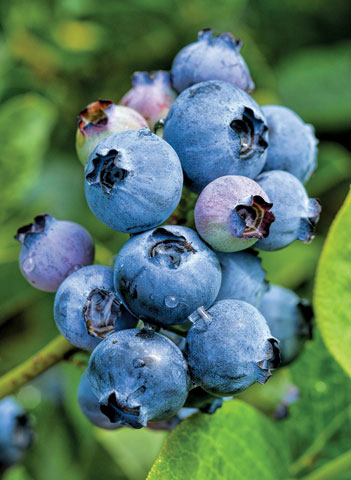Blueberry Pesticide Update
By Dani LightlePesticide Registration Research Leader, Oregon State University
Several new materials have become available to the blueberry industry over the 2020 growing season. These new options help diversify control options and add another tool for resistance management of insect pests and diseases.
 |
The most recently labeled is Orondis Gold (oxathiapiprolin + mefenoxam; FRAC 49 + 4). This premix from Syngenta is now available for control of Phytophthora root rots in both new and established blueberry plantings. Orondis Gold must be soil applied and irrigated into the root zone. Practicing good resistance management is critical for maintaining the longevity of this material and rotation with other Phytophthora-targeting materials is required per the label. Rotational options include Aliette (Fosetyl-al, FRAC 33).
Materials that became available throughout 2020 include FujiMite SC, Transform WG and Fontelis.
FujiMite SC (fenpyroximate; IRAC 21A) is labeled for spider mites, with a 1-day PHI. Rotation of products with different modes of action (MOAs) is key for mitigating spider mite resistance development. Unfortunately, the only other currently labeled miticide for bearing blueberries (Magister SC) is also a group 21A material, though products with additional MOAs are working their way through the registration pipeline (see below). However, in non-bearing blueberries, FujiMite can be rotated with Acramite 4SC (IRAC 20D) and Omite 30WS (IRAC 12C).
Transform WG (sulfoxaflor; IRAC 4C) provides control of aphids and suppression of scales and stink bugs. Because activity is limited to piercing/sucking type insects, impacts on natural enemies may be lower than alternative options. However, be aware that Transform drift is highly toxic to honeybees and other pollinators which may be present in the field if blooming weeds are present.
Fontelis (penthiopyrad; FRAC 7) is labeled for mummy berry, phomopsis twig blight and Botrytis. Botrytis resistance to FRAC 7 fungicides has been documented in the Willamette Valley, so be sure to tank mix Fontelis with another MOA to achieve Botrytis control and prevent further development of resistant strains. Other label restrictions for Fontelis include avoiding use on the variety ‘Star’ and no use of adjuvants post-petal fall.
A wide variety of materials continue to work their way through the registration process by way of the IR-4 Project, which facilitates registration of pesticides on specialty crops like blueberry. While the industry won’t see labels for these materials for several years still, projects which are ongoing include bifenazate (Acramite 4SC) and abamectin (Agri Mek SC) for spider mite control, buprofezin (Centaur WDG) for scales and flonicamid (Beleaf 50SG) for aphids.
Finally, I’ve continued to update the Oregon Blueberry Pesticide Registration handout and the Blueberry MRLs handout. Find the most recent versions here: https://agsci.oregonstate.edu/nwrec/research/ir-4specialty-crops-registration